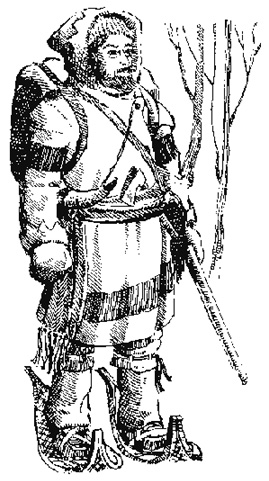 "One of the region’s most famous residents was none other than Jean-Baptiste Lagimodière (La Prairie). He is the Grandfather of Louis Riel. His name has been given to the elementary school in Lorette and one of Winnipeg’s main roads (Lagimodière / Hwy 59). He gave the Parish of Lorette its first bell in 1883.
"One of the region’s most famous residents was none other than Jean-Baptiste Lagimodière (La Prairie). He is the Grandfather of Louis Riel. His name has been given to the elementary school in Lorette and one of Winnipeg’s main roads (Lagimodière / Hwy 59). He gave the Parish of Lorette its first bell in 1883.
"Mr. Lagimodière is best remembered for his Midwinter Tramp, based on an article printed by the “Free Press Prairie Farmer” in (date?), titled “The Great Midwinter Tramp of Jean Baptiste Lagimodière, When a Canadian Hunter-Hero Snowshoed Two Thousand Miles to Save the Selkirk Settlement”, by W. R. Lowe.
"Born on Christmas Day 1778 in St Antoine sur Richelieu, Québec, Jean Baptiste went west in 1800 to join the fur trade. He found work in the Grand Portage area of Minnesota. He married a …[First Nation] woman and they had three daughters. In 1805 he returned home and married Marie Anne Gaboury. They returned to work in the north-west traveling around what would become Alberta and Saskatchewan.
"In 1811 he set out for the Forks because he had heard that settlers would be coming to the area and he offered his services to the HBC. He was hired on a one-year contract paying 30 Pounds. JB was a great hunter who could keep their hunting parties supplied with food. Lagimodière is said to have been independent minded and didn’t automatically side with the Métis on political issues which explains his work with the HBC.
"(…) HBC agent Colin Robertson asked Lagimodière to take letters to Lord Selkirk in Montreal, telling of their plight and requesting aid. He set out October 17, 1815 travelling part of the way on horse. A man named Benoni Mairier and a…[unnamed First Nation] guide initially accompanied him. But later on he was entirely on his own. He carried no food and had to find everything he ate on the way. The return was even more difficult…”
George Siamandas,
The Man Who Walked 1,800 Miles,
Winnipeg Time Machine
Sources:
Siamandas, G. (2009, April 12). The Man Who Walked 1,800 Miles. The Winnipeg Time Machine website/blog. Retrieved June 20, 2020 from JEAN-BAPTISTE LAGIMODIERE
Champagne, L. (1985-2020). LAGIMODIÈRE (Lagimodière, Lajimonière, Lavimaudier, Lavimodière) Jean-Baptiste. Dictionary of Canadian Biography, VIII (1851-1860). University of Toronto/Université Laval. Retrieved July 1, 2020 from http://www.biographi.ca/en/bio/lagimoniere_jean_baptiste_8E.html
Image scanned from the Manitoba Archives

Lagimodière passed away in 1855, long before the story of the Dawson Road (1868-1878), however “After his famous trek to Montreal, Jean-Baptiste Lagimonière served as messenger for the HBC on many occasions, as did his sons. He also began to farm some land that Selkirk is said to have granted him for his services. It was on this land, which was at the mouth of the Seine River [in Lorette], that he built a home where he brought up his family of four girls and four boys. In 1844 his daughter Julie married a neighbour, Louis Riel*, and later that year gave birth to a son, Louis*, who was to become the principal leader of the Métis during the events surrounding the entry of Manitoba into confederation.” Canadian Dictionary of Biography. Retrieved June 5, 2020 from Biography – LAGIMONIÈRE, JEAN-BAPTISTE – Volume VIII (1851-1860); Jean Baptiste Lagimodière known as La Prairie; https://images.app.goo.gl/UCmcKQiFthzgEzwu8
Back to Notre-Dame-de-Lorette Church Heritage Tour page | Top
Previous page: First Reeve of Taché Signed his Name with an “X”
Next page: Louis Riel Land Claim East of Lorette
